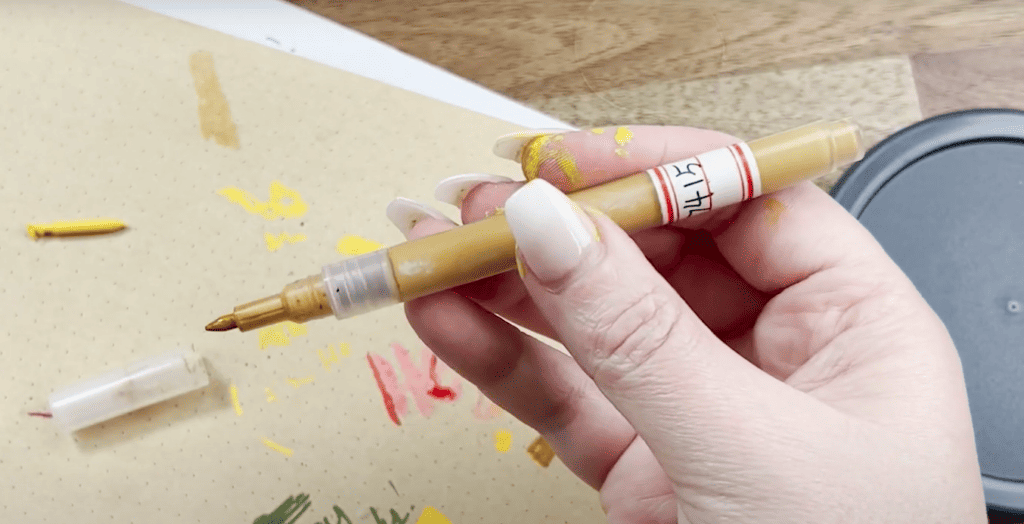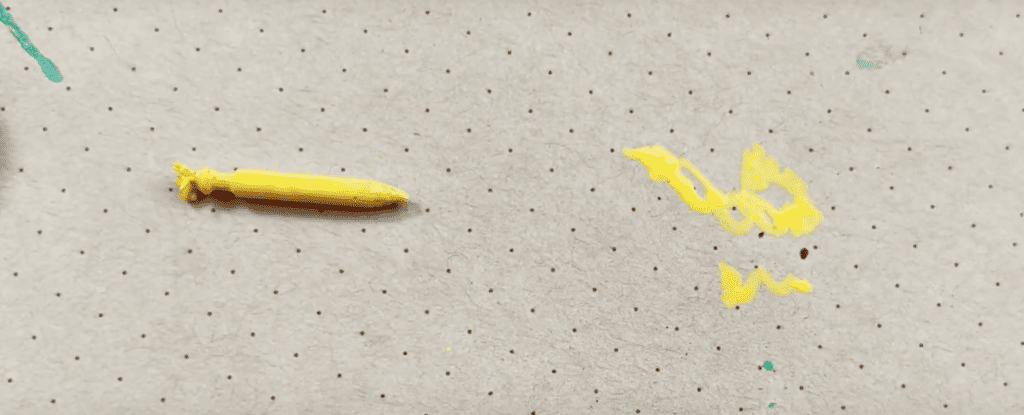Troubleshooting Guide for Acrylic Paint Pens: Dry? Clogged? Broken? Stuck?
Acrylic paint markers have surged in popularity, captivating artists and creative enthusiasts alike with their vibrant hues and versatile application. As the art world continues to evolve, these dynamic tools have carved a distinct niche for themselves, permeating various creative projects with their exceptional capabilities. In this exploration, we delve into the realm of acrylic paint markers, igniting a passion for acrylic paint marker drawing while revealing a world of boundless artistic possibilities. We are going to cover both Posca and Acrylograph Acrylic Paint Pens
When using paint pens, choosing the right notebook is essential to ensure your artwork shines. Opt for notebooks with heavyweight paper that can handle the ink without bleeding through or warping. Look for paper labeled as “mixed media” or “marker paper,” as these types are designed to handle a variety of mediums, including paint pens. Notebooks with smooth paper surfaces facilitate seamless blending, while textured papers can add an interesting dimension to your artwork.
Consider brands like Mosseryco, Strathmore, and Canson, which offer high-quality notebooks suitable for paint pen creations. Always test a small area before committing to a full artwork to ensure the paper meets your expectations. A suitable notebook enhances your paint pen experience, allowing you to explore your creativity with confidence.
The Excitement of Acrylic Paint Marker Drawing
Imagine a blank canvas awaiting the touch of acrylic paint markers – a blank canvas that holds within it the potential to transform mere thoughts into vivid realities. The world of acrylic paint marker drawing thrives on the exhilaration of turning imagination into tangible art. With a single stroke, artists can capture emotions, convey stories, and experiment with techniques that push the boundaries of traditional artistry. This artistic odyssey is fueled by the excitement of wielding acrylic paint markers to create expressive strokes, intricate details, and bold statements on a wide array of surfaces.
Unlocking Endless Creative Pathways: Acrylic Paint Marker Ideas
Embracing acrylic paint markers isn’t just about applying pigment to a surface; it’s about exploring a multitude of innovative ideas that transcend traditional artistic mediums. These markers breathe life into projects that span from personalized home decor to elaborate mixed-media artworks. The possibilities are as diverse as the imagination itself. Whether sketching vibrant landscapes, crafting intricate designs, or adorning everyday items with personalised artwork, acrylic paint markers empower creators to traverse endless creative pathways.
A Smooth Sail Through Paint Marker Challenges: The Importance of Troubleshooting
While the world of acrylic paint markers is undoubtedly exhilarating, it’s not without its challenges. To navigate this realm with finesse, understanding common issues and mastering troubleshooting techniques is essential. From ensuring a steady flow of pigment to reviving dried-out markers, troubleshooting transforms potential frustrations into valuable learning experiences. This aspect forms the cornerstone of an artist’s journey, allowing them to maintain momentum even when encountering minor setbacks.
From the allure of acrylic paint marker drawing to the tapestry of acrylic paint marker ideas, every stroke of creativity is underpinned by the versatile tools at hand. Acrylic paint pens, including Amazon’s array of options, offer a rich spectrum of expression. Whether it’s the finesse of an acrylic paint brush pen or the precision of a paint pen, each stroke is laden with potential. The likes of Posca and Acrylograph emerge as steadfast companions, providing not just paint pens, but gateways to unfettered imagination. Within this synergy, we find posca paint pens and posca paint markers coalescing with acrylic paint pens posca, creating a symphony of artistic prowess.
Intricate details come alive with the acrylic paint marker pen, capturing nuances and evoking emotions with each movement. The acrylic paint marker set expands horizons, offering a comprehensive palette that aligns with even the most vivid of visions. Acrylograph pens, including the revered Archer and Olive acrylograph, emerge as tools of refined expression, transforming stationery into a testament of creativity. As reviews unfold and pen tests are conducted, the world of acrylic paint markers unveils its secrets, guiding creators toward mastering their chosen medium.
As we venture deeper into the heart of acrylic paint markers, remember that each stroke is a journey, and each creation a masterpiece in the making. The realm of acrylic paint marker drawing beckons with a world of vibrant hues and endless exploration. By understanding the nuances of troubleshooting, creators ensure that their artistic odyssey is marked by fluidity and growth. So, embrace the potential of acrylic paint markers, create with boundless imagination, and elevate your artistry to new heights, one stroke at a time.
Understanding Your Tools: Navigating the Array of Acrylic Paint Pens
In the vast universe of artistic tools, acrylic paint pens stand out as versatile gems, offering artists a range of possibilities that go beyond traditional mediums. As you embark on your creative journey with these dynamic tools, let’s explore the diverse landscape of acrylic paint pens, from renowned brands like Posca and Acrylograph to the various types that unlock unique artistic expressions.
Brands of acrylic paint pens
Acrylic paint pens have become synonymous with innovation and quality, with brands like Posca and Acrylograph leading the charge. Posca, known for its bold pigments and smooth flow, has garnered a loyal following for its consistency and vibrant color range. On the other hand, Acrylograph pens, including the highly regarded Archer and Olive acrylograph, present a blend of style and substance, elevating stationery to an art form. The diversity in these brands offers creators the freedom to align their preferences with their creative visions, ensuring that each stroke is a reflection of their unique artistic identity.
Brush Pens and Traditional Pens: A World of Technique
Within the realm of acrylic paint pens, two prominent types take center stage: brush pens and traditional pens. Brush pens emulate the texture and versatility of traditional brushes, allowing artists to create varying line widths and experiment with different strokes. These pens excel in producing fluid lines and intricate details, making them ideal for calligraphy, watercolor-style applications, and expressive brushwork. On the other hand, traditional pens provide precise control and are perfect for finer details and defined lines. The choice between these two types depends on your artistic style and the specific effects you aim to achieve.
Exploring Acrylic Paint Marker Ideas
Acrylic paint pens are more than just tools; they’re catalysts for creativity. The very act of holding an acrylic paint pen opens the door to a world of acrylic paint marker ideas waiting to be explored. Whether you’re adorning journals with intricate patterns, embellishing greeting cards with personalized touches, or transforming ordinary objects into artistic masterpieces, acrylic paint markers amplify your creative voice. They enable you to infuse art into the everyday, turning mundane moments into opportunities for self-expression. With each stroke, your ideas come to life, making your artistic journey truly immersive and inspiring.
How is the acrylic paint pen made? What is inside the paint pen?
Inside an acrylic paint pen lies a clever design. The paint itself is water-based, consisting of pigment particles suspended in water. This composition allows for smooth application and easy blending. To ensure consistent consistency, a small mixing ball is present within the pen. When shaken, it agitates the paint, preventing it from becoming too thick or separated. This ingenious mechanism guarantees that your paint pen is always ready to deliver vibrant and precise strokes, making your creative journey seamless and enjoyable.

Activating Acrylic Paint Pens
Acrylic paint pens hold the promise of vibrant, flowing pigments, ready to transform your artistic visions into reality. Yet, like any tool, they require a certain level of understanding and preparation to ensure they perform at their best. Before you embark on your creative journey, let’s explore the crucial process of activating new acrylic paint pens and uncover the secrets to ensuring a flawless start.
Paint pens provide a convenient way to work with acrylic-based inks. Before diving into techniques, let’s cover some essential steps to ensure you get the best results:
- Activation: Shake the pen vigorously to activate the ink. This is akin to priming a paintbrush before use.
- Consistent Flow: Maintain a steady flow by occasionally shaking the pen while using it. This prevents clogging and ensures even distribution of ink.
- Understanding Paint Properties: Paint pens function similarly to picking up paint with a brush. You draw with the pen, put down the ink, and then shake it again before the next application.
Unlocking the Freshness: Activating New Acrylic Paint Pens
When you first uncap a new acrylic paint pen, you’re greeted with the potential for an array of captivating strokes. However, acrylic pigments can sometimes settle within the pen during storage, which may require a little coaxing to bring them back to life. Activating your new pens involves a simple but important process that guarantees optimal performance.
Shake, Shake, Shake: The Key to Vibrant Pigments
The first step in activating your acrylic paint pen is to give it a good shake. Hold the pen with the cap on and shake it gently but vigorously. This motion helps disperse the pigment evenly throughout the pen, ensuring that you get consistent and vibrant colors from the first stroke.
Prime for Perfection: Proper Priming Techniques
After shaking, it’s time to prime the pen to ensure a smooth and steady flow of paint. Follow these steps:
- Cap Off: Remove the cap from the pen, exposing the tip.
- Press and Release: Holding the pen vertically with the tip facing down, gently press the tip against a scrap piece of paper. Press and release multiple times until you see the paint flow smoothly onto the paper. This process helps saturate the tip with pigment, ensuring that your first strokes are as vivid as possible.
- Test the Flow: Test the pen on a scrap piece of paper to confirm that the pigment flows smoothly and consistently. If you notice any inconsistencies, repeat the priming process until you achieve the desired result.
Reviving Dried Out Acrylic Paint Pen Markers
Acrylic markers, the dynamic tools that infuse life into your creations, sometimes face the inevitable challenge of drying out over time. As an artist, encountering a dried-out marker can be disheartening, but fear not, for there are simple yet effective ways to revive these prized companions and ensure that your artistic journey remains uninterrupted. Let’s delve into the art of reviving dried out markers, exploring step-by-step instructions and valuable tips for maintaining their longevity.
Addressing the Common Woe: Acrylic Markers’ Drying Woes
Drying out is a common issue faced by acrylic markers, whether due to prolonged disuse or exposure to air. This phenomenon can interrupt your creative flow and potentially lead to frustration. However, it’s important to note that a dried-out marker doesn’t necessarily mark the end of its usefulness. Instead, it’s an opportunity to learn the art of marker revival and reinforce the bond between an artist and their tools.
Step-by-Step Dry Marker Resuscitation: A Guide to Restoration
- Gather Your Supplies: You’ll need the dried-out acrylic marker, a shallow container of water, a clean cloth or paper towel, and patience.
- Dampen the Tip: Gently dip the marker’s tip into the container of water. Ensure that the water level is shallow enough to cover only the tip without soaking the entire marker.
- Absorb Excess Water: After allowing the tip to absorb water for a few seconds, carefully remove it from the water. Blot the excess water using a clean cloth or paper towel. The goal is to rehydrate the tip without oversaturating it.
- Test on Scrap Paper: Test the marker on a scrap piece of paper. You might notice the pigment beginning to flow again. It might take a few strokes before the marker returns to its original vibrancy.
- Be Patient: Repeat the process of dampening the tip, blotting, and testing until the marker produces consistent, fluid lines. Remember, patience is key to achieving the best results.
Preserving Longevity: Cap and Store with Care
Preventing acrylic markers from drying out is as important as reviving them. To ensure the longevity of your markers, follow these practices:
- Cap Promptly: Always replace the cap on the marker immediately after use. This prevents excessive exposure to air, which is a primary cause of drying.
- Store Horizontally: When not in use, store your markers horizontally. This helps distribute the ink or paint within the marker evenly, reducing the likelihood of drying.
- Avoid Direct Sunlight and Heat: Store your markers in a cool, dry place away from direct sunlight and extreme temperatures. Heat can expedite evaporation, leading to premature drying.
Troubleshooting a Clogged Paint Pen
Even the most skilled artists encounter challenges when working with paint pens, and one common frustration is dealing with a clogged pen. When your paint pen isn’t flowing smoothly, it can disrupt your creative process. Don’t worry—troubleshooting a clogged paint pen is a manageable task. Here’s a step-by-step guide to help you tackle this issue:
Step 1: Identify the Issue
Before attempting to fix the clog, it’s important to identify whether the clog is in the nib or the ink flow. If the ink isn’t reaching the nib, it’s an ink flow problem. If the nib itself is dry, it’s a nib clog.
Step 2: Clearing an Ink Flow Clog
- Shake Vigorously: Give the pen a vigorous shake to ensure the ink is well-mixed. This can help dislodge any dry ink that might be causing the clog.
- Press and Pump: Press the tip of the pen against a scrap piece of paper or cloth. Pump the pen by gently pressing and releasing the tip. This can help encourage the ink to flow again.
- Prime the Nib: If the pen has a pump or valve mechanism, follow the manufacturer’s instructions to prime the nib and ink flow.
Step 3: Clearing a Nib Clog
- Remove the Nib: Some paint pens allow you to remove the nib. If yours does, carefully remove it and rinse it with water. Dry it thoroughly before reassembling.
- Soak the Nib: If the nib is resistant to water, you can soak it in warm water for a few minutes to loosen the dried paint.
- Use a Needle: Gently insert a fine needle or pin into the nib’s opening to clear any dried paint. Be cautious not to damage the nib.
- Flush with Water: If possible, flush the nib with warm water. This can help dislodge any particles obstructing the flow.
Step 4: Test and Prevent
After clearing the clog, test the pen on a scrap piece of paper to ensure it’s flowing smoothly. To prevent future clogs, always remember to:
- Store your paint pens horizontally to prevent settling of pigments.
- Recap your pen immediately after use to prevent the nib from drying out.
- Shake the pen well before use to ensure proper ink consistency.
Remember that patience is key when troubleshooting clogs. With a little effort and care, you can bring your paint pen back to life and continue creating without interruptions.
Troubleshooting a Watery or Runny Acrylic Paint Pen
Dealing with a watery or runny paint pen can be frustrating, but don’t let it dampen your creative spirit. Here’s a step-by-step guide to troubleshooting and resolving the issue of a paint pen that’s producing excessive or inconsistent flow:
Step 1: Understand the Cause
Before you can fix the issue, it’s important to understand why your paint pen is producing a watery or runny consistency. The most common reasons include under-shaking the pen, incorrect storage, or using the pen on a wet surface.
Step 2: Adjust Your Technique
- Shake Moderately: While shaking the paint pen is necessary to mix the pigments, over-shaking can lead to a watery consistency. Shake the pen for a shorter duration to avoid over-thinning the ink.
- Check Surface Conditions: Ensure that the surface you’re working on is dry. Using a paint pen on a wet or damp surface can cause the ink to spread more than intended.
Step 3: Test and Adjust
- Test on Scrap Paper: Test the pen on a scrap piece of paper before applying it to your artwork. This will give you an idea of the pen’s current consistency and help you adjust your technique.
- Dab on Scrap Paper: If the pen is excessively watery, dab the tip on a clean cloth or paper towel to remove excess ink before applying it to your artwork.
Step 4: Absorb Excess Ink
- Blot with Paper Towel: If you find that the pen is still too watery, gently blot the tip on a paper towel. This can help absorb excess moisture and create a more controlled flow.
Step 5: Allow for Drying Time
- Allow to Dry: If you’ve applied too much watery ink to your artwork, allow it to dry completely. Once dry, you can assess the effect and decide whether to work over it or make adjustments.
Step 6: Prevent Future Issues
- Proper Storage: Store your paint pens horizontally and in a cool, dry place. This prevents excessive evaporation of the solvent and helps maintain the desired consistency.
- Cap Securely: Always cap your paint pens immediately after use to prevent evaporation and maintain the ink’s viscosity.
Trouble shooting a frayed, stuck or broken nib in your paint pen
Dealing with a depressed or stuck nib in your acrylic paint pen can be frustrating, but here’s how to troubleshoot and fix the issue:
- Clean the Nib: Sometimes, debris or dried paint can cause the nib to get stuck. Gently wipe the nib with a damp cloth to remove any residue.
- Warm Water Soak: If the nib is clogged, you can remove it from the pen (if possible) and soak it in warm water for a few minutes. This can help dissolve dried paint and unclog the nib.
- Nib Movement: Gently press and release the nib a few times. This can help loosen it if it’s stuck due to dried paint.
- Nib Replacement: If the nib remains depressed or stuck, you might need to replace it. Many paint pen brands offer replacement nibs that you can easily insert.
- Nib Maintenance: To prevent this issue in the future, make sure to cap the pen when not in use to prevent the nib from drying out. Also, store the pen horizontally to ensure an even flow of paint to the nib.
Remember, patience is key. Avoid using excessive force that might damage the nib or the pen itself. With proper care, you can keep your acrylic paint pen in great working condition for all your creative projects.

Mastering Acrylic Paint Marker Techniques
Embarking on an acrylic paint marker drawing journey is an exhilarating experience, but like any creative pursuit, it comes with its set of challenges. As you wield your acrylic paint markers to give life to your artistic visions, it’s essential to be equipped with troubleshooting techniques that navigate common drawing issues. Let’s dive into a realm of solutions, unraveling the threads of inconsistent flow, streaking, bleeding, and the art of mastering techniques to ensure your creative expressions shine.
Navigating the Creative Maze: Addressing Common Drawing Issues
- Inconsistent Flow: Striking a Balance Inconsistent flow is a frustrating issue that can disrupt the fluidity of your drawing. It often occurs when the paint marker’s pigment isn’t evenly distributed or when the pen isn’t primed properly. To address this, shake the marker well before use to ensure proper pigment dispersion. If the problem persists, try priming the marker on a scrap piece of paper, as discussed earlier, to achieve a consistent flow.
- Streaking: Taming Uneven Lines Streaking can result from uneven pressure, irregular pen movement, or varying pigment saturation. To overcome this challenge, maintain a steady hand while drawing, applying consistent pressure. Avoid lifting the pen from the surface mid-stroke, as it can lead to streaks. Additionally, ensure the pen is properly primed to prevent uneven pigment distribution.
- Bleeding: Controlling Pigment Spread Bleeding occurs when the paint marker’s pigment spreads beyond the intended lines, creating a blurred effect. This can happen on porous surfaces or if the marker is over-saturated. To prevent bleeding, choose non-porous surfaces when possible. If using a porous surface, be mindful of the amount of paint applied. Consider allowing layers to dry before adding additional details to reduce the risk of bleeding.
The Art of Adjusting Techniques: Crafting Desired Outcomes
- Pressure and Line Variation: Control in Your Hands Adjusting the pressure you apply to the marker can create a diverse range of line thicknesses and textures. Experiment with light pressure for thin lines and heavy pressure for bolder strokes. Mastering this technique adds depth and dimension to your artwork.
- Blending and Layering: Harmonizing Colors Acrylic paint markers offer the opportunity to blend and layer colors seamlessly. Start with a light layer of color, and gradually build up intensity by layering additional strokes. For blending, work quickly while the paint is still wet, using overlapping strokes to achieve a smooth transition between colors.
- Texture and Techniques: Innovating with Mediums Acrylic paint markers can be used in conjunction with other mediums, enhancing your creative arsenal. Experiment with techniques like cross-hatching, stippling, and dry brushing to add texture and depth to your artwork. Combine markers with acrylic paints to create dynamic mixed-media pieces.
Achieving beautiful blends with paint pens is an art that rewards practice and experimentation. Blending colors seamlessly can elevate your artwork to a new level. Here’s how to master the art of blending:
Smooth Blending: Apply colors with a wet edge for seamless transitions
One of the most effective techniques for achieving smooth blends with paint pens is to work with a wet edge. This involves applying a new color of paint while the previous one is still wet. The wet edges of both colors naturally meld together, creating a gradual transition from one hue to the next. This technique works particularly well on smooth paper surfaces, where the paint has a bit more time to interact and merge. The result is a visually pleasing and almost gradient-like effect that can add depth and dimension to your artwork.
Working with Different Brands: Unleash the Unique Qualities of Each Brand
Paint pen brands like Posca, Karin, and Acrylographs each come with their own set of characteristics and attributes. Exploring these differences can open up new creative possibilities in blending:
- Posca Markers: Posca markers are known for their vibrant and opaque colors. When blending with Posca, keep in mind that the opacity of the paint can affect the final result. Layering different Posca colors can lead to rich and intense blends, while also offering the opportunity to create captivating overlays.
- Karin Markers: Karin markers offer a unique blend of smoothness and streakiness. To achieve smooth blends, ensure that you keep the edges of your colors wet. This technique helps minimize streaks and results in a more even transition between colors. Karin markers can excel in producing soft gradients and delicate color shifts.
- Acrylographs: Working with Acrylographs requires a slightly different approach. These markers often benefit from thorough shaking and gentle dabbing to ensure a consistent flow of paint. Due to their opacity, Acrylographs are excellent for layering and creating depth. Blending with Acrylographs might involve applying multiple layers of paint and allowing them to interact for unique textural effects.
Layering and Overlays: Unleash Opacity and Depth
Experimenting with layering and overlays can yield fascinating results when working with paint pens:
Layering different colors involves applying one color over another. By layering opaque colors, you can achieve striking effects. For instance, layering a translucent color over a more vibrant one can create a sense of depth and luminosity in your artwork. This technique is particularly powerful when working with paint pens that have a high opacity, like Acrylographs.
Overlays, on the other hand, involve applying one color over another while allowing some of the underlying color to show through. This technique can be used to create complex color variations and add texture to your artwork. Experimenting with different pressure levels and stroke techniques can produce diverse overlay effects, contributing to the overall depth and visual interest of your piece.
Incorporating these blending techniques into your artistic practice will enable you to harness the full potential of paint pens and create artworks that are rich in color, texture, and dimension.
Posca vs. Acrylograph: Navigating the Choice of acrylic paint pens
When it comes to acrylic paint markers, the choice between brands can be as significant as the colors you select. Posca and Acrylograph are two prominent players in this creative arena, each with its own set of strengths and characteristics. As you stand at the crossroads of choice, let’s dive into the world of Posca and Acrylograph, exploring their distinctions, identifying situations where they shine, and drawing on personal experiences and reviews to illuminate your path.
Unveiling the Brands: Posca and Acrylograph in the Spotlight
Posca: Vibrancy and Versatility Posca has earned its place as a beloved brand known for its vivid pigments and versatility. With a wide array of colors that pop on various surfaces, Posca markers offer a consistent flow of paint that allows for both fine details and bold strokes. They’re celebrated for their opacity and ability to cover darker surfaces effectively. Posca’s user-friendly design makes it suitable for artists of all levels, from beginners to seasoned professionals.
Acrylograph: Elegance in Every Stroke Acrylograph, with the distinguished Archer and Olive acrylograph leading the charge, is celebrated for its elegance and quality. These markers often come with fine brush tips, mimicking the experience of using traditional brushes. The pigments are designed to flow smoothly, making them an excellent choice for artists seeking precision and control. Acrylograph pens are particularly favored among calligraphers and those who value intricate, detailed work.
Matching the Brands to Your Artistic Intentions
Posca: Bold and Diverse
- Choose Posca if you’re looking to work on a variety of surfaces, including paper, fabric, wood, and even ceramics.
- If your project demands bright and vibrant colors that stand out against both light and dark backgrounds, Posca’s opaque pigments are well-suited.
- Posca markers are versatile tools for mixed-media projects, graffiti art, and crafting.
Acrylograph: Elegance and Precision
- Opt for Acrylograph if your artistic pursuits involve calligraphy, hand lettering, or fine detail work.
- If you’re drawn to a wide range of colors, A&O Acrylographs lead the charge here
- Acrylograph markers excel on paper-based projects, especially those where intricate details and controlled lines are paramount.
When it comes to showcasing the capabilities of paint pens on paper, exploring various brands and their distinctive attributes can offer valuable insights into their performance. Let’s dive deeper into how different paint pen brands fare on paper and what makes each brand unique:
Posca Markers: Vibrant Opacity and Layered Boldness
Posca markers are renowned for their vibrant and opaque colors, making them an excellent choice for creating impactful artworks. These markers possess the ability to cover the underlying surface with a bold layer of paint, resulting in artworks that pop with intensity. The real magic of Posca markers comes alive when they are layered. Layering different Posca colors not only adds depth and dimension but also enhances the richness of the hues. This ability to build layers allows artists to achieve complex color variations that command attention.
Karin Markers: Smooth Blends with a Hint of Texture
Karin markers offer a unique blend of smoothness and texture in their application. When used for blending, Karin markers have the potential to create soft gradients that transition seamlessly from one color to another. However, it’s important to note that Karin markers can sometimes exhibit streakiness. To mitigate this, maintaining wet edges while working can lead to smoother transitions and reduce streaks. The ability to achieve smooth blends while still incorporating a hint of texture gives Karin markers a distinct advantage in producing visually captivating artworks.
Acrylographs: The Art of Opacity and Layering
Acrylographs bring a different dimension to the world of paint pens. These markers require a more deliberate approach—thorough shaking and gentle dabbing are essential to ensure a consistent flow of paint. What sets Acrylographs apart is their opaque nature. The opacity of the colors they deliver allows artists to create captivating layering effects. By applying multiple layers of paint and allowing them to interact, artists can achieve a sense of depth and complexity that’s hard to replicate with other types of markers. This opacity also enables Acrylographs to excel in producing artworks with a rich and textured appearance.
Choosing the Right Tool for Your Vision
When showcasing paint pens on paper, understanding the attributes of each brand empowers artists to make informed decisions based on their artistic vision. Posca markers are ideal for bold and vibrant creations, Karin markers offer a balance between smooth blending and textural interest, while Acrylographs introduce the world of opacity and layered effects. The right choice depends on the effect you want to achieve and the story you wish to convey through your artwork.
Exploring Acrylic Paint Marker Ideas: Unleash Your Creative Odyssey
Acrylic paint markers open the door to a world of endless creative possibilities, where your imagination knows no bounds. These vibrant tools offer a versatile medium that’s not confined to traditional canvases alone. Let’s embark on a journey through an array of acrylic paint marker ideas that span across various projects and surfaces, encouraging you to push the boundaries of your creativity and breathe life into your artistic visions.
Diverse Canvas of Creativity: Acrylic Paint Marker Projects
- Personalized Art Journals: Transform the pages of your art journal into a kaleidoscope of color. Whether you’re sketching intricate mandalas, journaling your thoughts, or creating visually stunning spreads, acrylic paint markers add a vibrant touch to your personal expressions.
- Customized Home Decor: Elevate your living spaces with customized decor pieces. Design your own coasters, plant pots, or decorative plates with intricate patterns, inspiring quotes, or playful designs using acrylic paint markers.
- Wearable Art: Express your creativity on fabric by embellishing plain t-shirts, canvas shoes, or denim jackets. Acrylic paint markers lend themselves well to creating wearable masterpieces that reflect your unique style.
- Greeting Cards and Invitations: Craft one-of-a-kind greeting cards, invitations, and thank-you notes. The precision of acrylic paint markers ensures your sentiments are beautifully illustrated and memorable.
- Wooden Creations: Unleash your artistic flair on wood. Paint markers work wonders on wooden surfaces, whether you’re adorning small trinkets, creating rustic signs, or revamping furniture pieces with intricate designs.
- Mixed-Media Collages: Combine acrylic paint markers with other mediums like watercolors, colored pencils, or ink to create captivating mixed-media collages that tell a layered and textured story.
- Personalized Gifts: Make your gifts stand out by adding a personal touch. Acrylic paint markers allow you to customize mugs, keychains, and more, turning everyday items into cherished keepsakes.
A World of Surfaces: Versatility in Application
Acrylic paint markers transcend traditional boundaries, adapting to a multitude of surfaces:
- Paper: Smooth or textured, paper provides a versatile canvas for illustrations, doodles, and intricate details.
- Canvas: The classic canvas becomes a playground for bold strokes, vivid colors, and expressive designs.
- Wood: From home decor to crafts, wood surfaces offer an earthy backdrop for your creativity.
- Fabric: Give life to garments, accessories, and textiles with your unique designs using fabric-friendly acrylic paint markers.
- Glass and Ceramic: Transform glassware, ceramics, and porcelain into stunning works of art that light up your living spaces.






